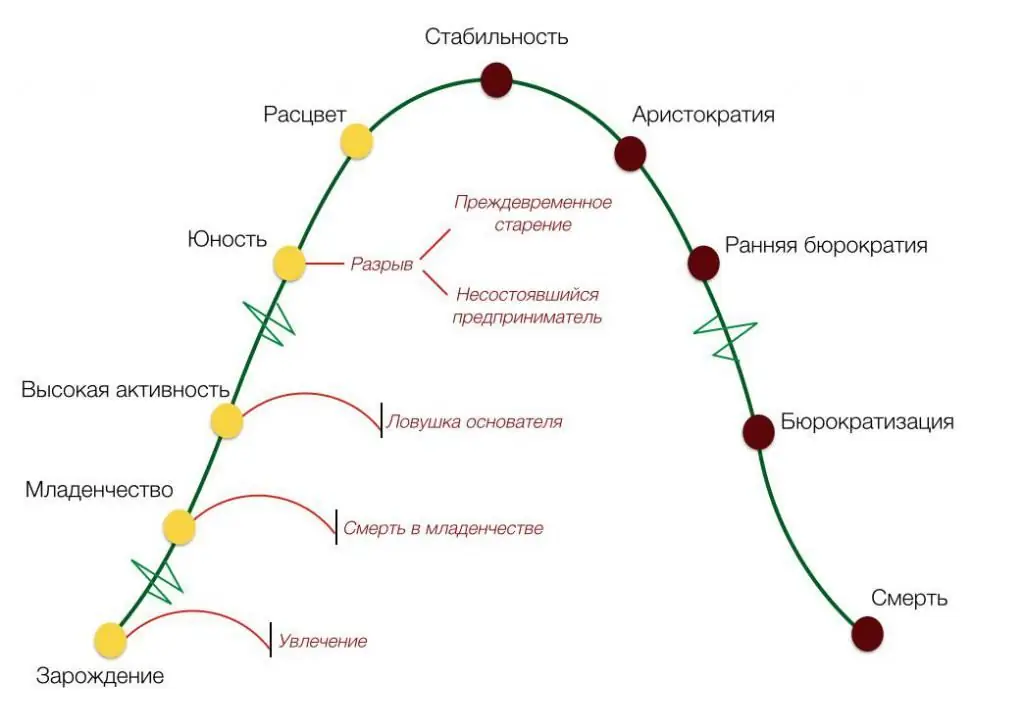2025 Author: Howard Calhoun | [email protected]. Last modified: 2025-01-24 13:10:41
The management process is the organization of all types of business activities of an enterprise. Based on this definition, management cannot be separated from its object, and the nature of the functions of the management cycle depends on the specifics of the production or trade process.

General and special control functions
In the process of organizing the business activities of a company, two types of functions are implemented: those related to general (which can apply to all systems) or specific only to this system.
Common functions relate to those areas that are organized in a similar way in different enterprises, for example, control of mail delivery, cleaning of office premises, repair of office equipment. Specific functions are inherent in the management process at a particular enterprise (search for specialists to program packaging robots or repair a conveyor belt).
Management cycle of an organization
In general, the management of the company provides for the implementation of the following tasks:
- Development of long-term and current plans.
- Organization and regulation of production (trading, consulting or other) activities.
- Motivation and coordination of staff.
- Monitoring and recording the results of the production process.
These groups of functions make up the stages of the management cycle, which is expressed in planning, organization, motivation and control.

The management cycle is called it because this sequence of management actions is characterized by continuity. It has a beginning, then must repeat for a certain period of time (week, decade, month, quarter, year).
The value of planning in the context of the enterprise's activities
This function is rightly called the most important in the entire management process. Its implementation ensures proportional production volumes, the smooth operation of various departments, as well as the rational use of available material, labor and financial resources. Up-to-date and competent planning is necessary for organizing the correct course of production, that is, for the dynamic balance of internal production processes.

In fact, planning can be called setting goals and determining ways to achieve them.
Types of planning: strategic
Development of plans, as the first of the stages of the management cycle, precedes all others. Each level of organization has a specific type of planning.
At the highestlevel develop strategic plans. In the field of production, strategy is the optimal set of rules and techniques that contribute to the implementation of the mission, as well as the achievement of the general and private goals of the company. The main task of strategic planning is to determine the main course, that is, the style of behavior of the company in a busy market niche.
Finding ways to bypass crises or gain new market positions also includes such management. The management cycle, the stage of which is strategic planning, is usually quite long. Typically, the development of global plans occurs every one, three or five years.
What is tactical and operational planning
At the middle and lower levels of management, tactical and operational plans are developed, respectively.
Tactical planning is the definition of intermediate goals designed to ensure the implementation of strategic objectives. This type of activity is included in the managerial cycle of middle managers.
The result of operational planning is those goals that are developed by managers directly at the places of execution. Their duties include setting daily goals (short-term tactics).

The described types of planning represent a general system - a general or general plan (a business plan for the operation of an enterprise). Planning is the only way to reduce market risk and uncertainty.
Planning Principles
Based on the fact thatthat the entire management cycle is based on planning, it should be carried out from the positions:
- Complexities. This means that all significant events and situations must be taken into account in the process.
- Accuracy. The construction of relevant and realistic plans becomes possible when using all available means, tactics, procedures and forecasting methods that modern technology provides.
- Continuity (the relationship between long-term and current planning).
- Flexibility (sometimes you need to give up ballast to achieve priority goals).
- Economy. Keeping planning costs proportional to the resulting benefits avoids unreasonably high costs.

The principle of integrity, which unites the process of developing long-term and current plans, is considered the main condition necessary for the continuity of the production process, the smooth operation of the enterprise and the stability of its economic contacts.
Organization stage
Organization is the next stage after planning, which continues the management cycle. At this stage, the manager's task is to create optimal conditions for the activities of all team members to be effective. He needs to coordinate the efforts of the staff and direct them to achieve their goals.
The implementation of this function becomes possible due to the formation of the organizational structure at the enterprise. For a successful implementationof planned activities, managers determine responsible persons and assign performers to specific tasks. In addition, it is their responsibility to ensure that throughout the entire technological process there is no shortage of resources (provision of equipment, finance, labor).
A few words about motivation
An integral component of every successful enterprise is the interest of the staff in the performance of their labor functions. Encouraging employees to be active, involving them in the joint achievement of corporate goals, as well as finding ways to improve their performance is called motivation.

The most common methods to help strengthen the "morale" of the employees of the organization are rewards:
- Material.
- Moral.
Means of material incentives include bonuses, bonuses and benefits, additional payments and gifts.
Emotional rewards are praise, public expression of gratitude, posting a photo on the honor roll, and others.
Control is the final stage of the management cycle
After actions have been taken to achieve the goals, their result must be measured, evaluated and compared with planned indicators.

The essence of control, which ends the management cycle, is to analyze the data and correct further instructions.
In management practice, there are three types of control:
- Preliminary.
- Current.
- Final.
Changing previous decisions and making adjustments to algorithms, instructions and rules become the beginning of a new management cycle. After all, it is necessary to re-plan activities taking into account new parameters, distribute tasks and monitor their implementation. The result of the new cycle is also subject to mandatory study and analysis.
Management cycle time
The main management cycles are characterized by flow in space and time. Their duration can be from several minutes to months, the place of application is groups, teams of performers and the company itself.
Therefore, we can talk about two types of measurement of the management cycle:
- Time.
- Space frames.
A good manager is interested in minimizing the time spent on each cycle as much as possible. Upon closer examination, one can see that the duration of the management process is influenced by the speed of performing the main actions: the collection, transfer and processing of information data, the cycle of management decisions (development and adoption), as well as the organization of execution.
Saving time resources is possible by simplifying organizational and documentary procedures, using technical means in the process of performing a number of procedures, as well as by reducing the time allocated for individual operations.
Recommended:
Stages of organization development. Organization life cycle

What do giants like McDonald's, Apple and Walmart have in common, besides having over 100,000 employees, is an interesting question. They all started small, with just a few people, and then grew. The stages of organizational development apply to domestic companies as well. All major manufacturers face transition periods. Basically, without government support and large investments, everything starts with small business
Corporate life cycle management: content, main theses, functions and goals

How to increase the viability of an organization, is it possible to manage the life cycles of a corporation and any other modern company. It turns out that everything is possible, especially if you apply the theory of Yitzhak Adiez - the modern recognized guru of effective management
Duration of the operating cycle. What is an operating cycle?

The company will not have problems with a lack of current assets if the management begins to strictly control the proportions between equity and debt capital, through which operations are financed
Shewhart-Deming cycle: stages of production management

Management seeks to develop effective ways to manage production and product quality. There are several approaches to solving this problem
Event management is the management of the organization of events. Event management and its development in Russia

Event management is a complex of all activities carried out to create mass and corporate events. At the same time, the former are called upon to provide powerful support to advertising companies, while the latter are aimed at strengthening the spirit within corporations

